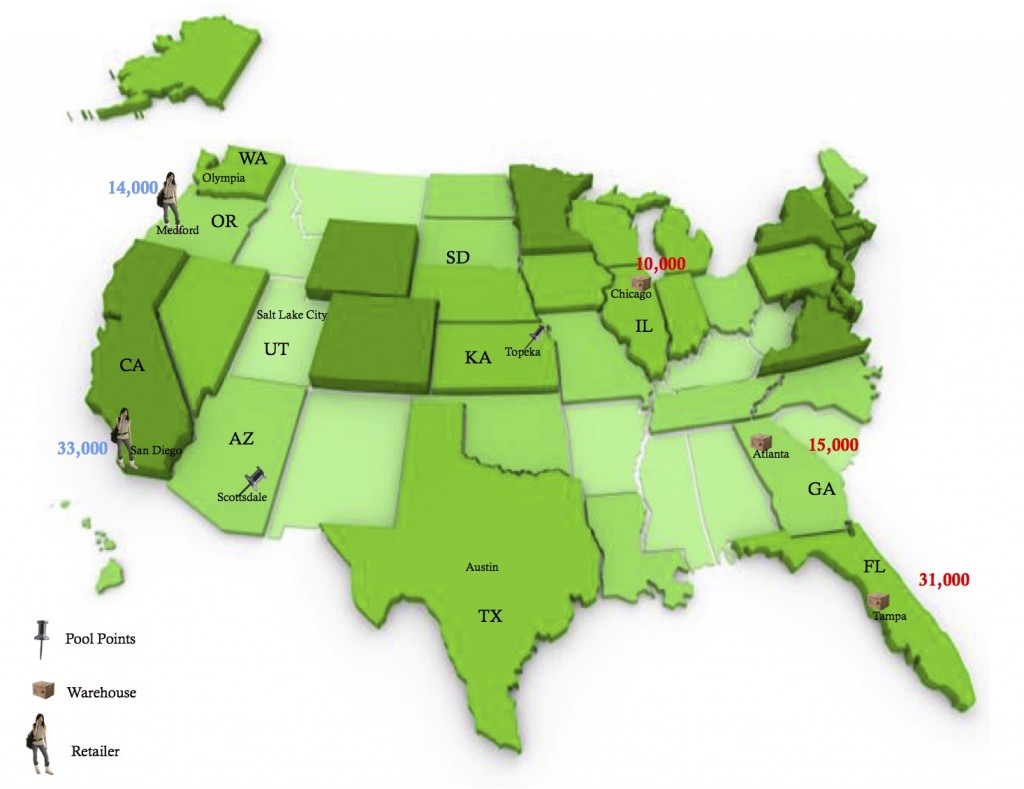A couple of weeks ago, I visited MIT to give a presentation on transportation management systems (TMS) to a masters class. The program director wanted to do something different this year: give the students a transportation optimization exercise for them to work on in class to see what answers they come up with relative to each other and a TMS. The problem couldn’t be too easy and straightforward, but it couldn’t be too complicated either (the students had about an hour to solve it). My co-presenter, Marsha Vacirca, Program Director for MercuryGate University, came up with the following problem:
 Ace Company is the only distributor of Le Fancy, a fashionable t-shirt line designed just for women. Ace has 3 distribution warehouses (Tampa, FL; Chicago, IL; and Atlanta, GA.)
Ace Company is the only distributor of Le Fancy, a fashionable t-shirt line designed just for women. Ace has 3 distribution warehouses (Tampa, FL; Chicago, IL; and Atlanta, GA.)
Current inventory for the Le Fancy t-shirts at the warehouses are 31,000 in Tampa, 10,000 in Chicago, and 15,000 in Atlanta.
Ace has a contract with Floyd Transportation to move goods from its distribution warehouses to retailers. Floyd Transportation charges a flat rate fee of $1.50 per mile regardless of how many t-shirts are in the truck (but max capacity is 30K t-shirts per truckload). Floyd Transportation also has pool points in Topeka, KS and Scottsdale, AZ.
Silver Tap, a large retailer that has had tremendous success selling the Le Fancy clothing line at its east coast stores will be opening its largest store in San Diego, California. Based on forecasted demand, Silver Tap ordered 33,000 t-shirts for the new San Diego store. Ace will only have 4 days to deliver the merchandise.
MK Retailer, another leading retailer located in Medford, OR, also ordered shirts from Ace. They need 14,000 t-shirts within 4 days as well.
Provide the best route that will deliver all the merchandise to both retailers on time at the lowest, most cost effective way possible. How many loads did you come up with? How many drops? Did you use pool points? If so, why and where?
Prior to the class, I attempted to solve the problem using the most popular TMS on the market — that is, an Excel spreadsheet. The MIT program director and one of his graduate students also worked on the problem, taking a more sophisticated linear programming approach, and Marsha modelled the problem using MercuryGate’s TMS.
The whole process — from coming up with the problem and working on it ourselves (which required several iterations) to seeing how the students approached the problem and the answers they came up with — was a great learning experience. I won’t go into all the details, but here are my key takeaways from doing this exercise:
- Even with a relatively simple problem, it takes time and effort to properly consider all of the variables involved in transportation planning. This is true not only when trying to solve the problem manually, but even when modelling it in the TMS. A tweak here, a tweak there — in terms of t-shirt demand, truck capacity, or pool point location, for example — and you come up with very different answers. Add in more complexity, like multiple modes, rate tables, hundreds of more orders, and more stringent time and other constraints, and the problem quickly becomes impossible to solve manually.
- Yes, data quality matters! In setting up the problem, we calculated the distances between all the warehouses, pool points, and retailers using Google Maps. For one of the pairs, we mistyped the mileage on the spreadsheet — we entered 2,000 miles instead of 3,000. Not surprising, this mistake impacted the results. We see this all the time in the real world too. For example, many times when companies take control of their inbound shipments, they discover that the optimized loads they create fall apart at execution because suppliers provided them with incorrect product dimensions or weights.
- If you’re using manual methods to plan/optimize your loads, you’re likely leaving money on the table. Many shippers that rely on Excel to plan their shipments, especially small and mid-sized companies, don’t believe they need a TMS because they’re getting the job done without one. But out of about 10 students teams, only two teams came up with the lowest-cost solution we had calculated, meaning most teams were overpaying to deliver the t-shirts. While the difference in cost might not have been large, when you multiply it by the number of shipments a company executes every day, every week, and every year, the money adds up quickly.
Are you smarter than a TMS? Go ahead and take the challenge. Prepare a problem for your transportation planners and ask them to solve it without the TMS. See what answers they come up with, relative to each other and your TMS. The process they take, and the questions they ask along the way, will be more valuable than the answers they calculate.
I’ll end with what I wrote back in December 2014 in Is Software Making Us Dumb?:
Should we turn off the software every once in a while, as a training exercise, and force ourselves to solve a problem manually? I believe so. It would force us to revisit and reinforce (or even learn for the first time) the fundamental concepts, logic, and math embedded in the software. We often treat software as a black box, where we enter data and out comes an answer, but if we don’t understand how the answer is derived, do we really know what we’re doing? And if we don’t truly understand how a process works, are we limiting our ability to drive continuous improvement and innovation?











